| Author |
Message |
Jared Smith

|
 Posted: Sun 03 Oct, 2010 3:48 pm Post subject: how to forge a francisca? Posted: Sun 03 Oct, 2010 3:48 pm Post subject: how to forge a francisca? |
 |
|
I wish to know if anyone has examined the "eye" or handle holes on surviving francisca heads and formed any opinion of how the handle was inserted and secured. Reproduction tomahawks have the hole tapered to be slightly smaller at the bottom of the axe head, and insert a tapered handle through the top of the axe head. The exposed handle top of present day tomahawk handles is the largest part such that a reproduction tomahawk head is not likely to fly off from centripetal acceleration while throwing or chopping, even if the head is loose.
I will follow up with a post of a picture of my first attempt at a francisca made by the "tomahawk" method. (Wrapping a bar around a tomahawk drift or "handle hole punching tool".) I did not start out with enough material to forge a pronounced beard on the cutting edge. Also, the thickness of material I happened to have just was not enough to really manage a straight tapered axe head like a maul. (My trial piece swells abruptly near the handle socket.) I did prove that I could get a fairly large area folded and welded solid with nothing but anvil, flux, and manual hammer using the wrap method though.
 Attachment: 53.84 KB Attachment: 53.84 KB
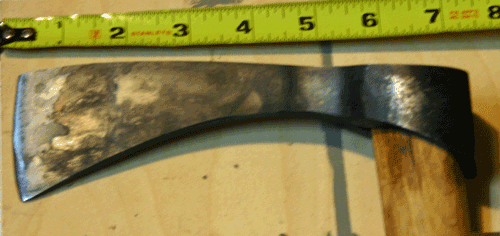
 Attachment: 29.32 KB Attachment: 29.32 KB

Absence of evidence is not necessarily evidence of absence!
|
|
  |
 |
|
Markus A
Location: Germany Joined: 03 Feb 2010
Posts: 61
|
 Posted: Mon 04 Oct, 2010 3:08 am Post subject: Posted: Mon 04 Oct, 2010 3:08 am Post subject: |
 |
|
i have had about 10 in my collectors time.your axe does not look at an franziska its much to long.the angle of the sockethole is wrong as the back.the whole outlines are incorrect.and the material is much to thin.the axes shows when looked from above an definte wedgeform.because its fored form an massive bar of iron not from an much to thin band like yours.at moment your axe has not 1 percent resemblance with an true franziska.
the franziska has alwas an oval socket.the socket is always at the very end of the axe itself.its not tapering.it stays as wide at top as at base.the shaft of an throwing axe is never straight.the butt of the axe is stout and boxlike.
i had slavik varianats with triangulary lugs at lower seam.the socket whole was punched in while the iron was hot.i never ahd one which where forged like an band and then welded at the side or near the blade.such thing accure only in medieval axes,and are no sign of low quality.
and good franziska weights around 300-400 gramms head alone.the upper line must look like and lying S.and the back butt plate end is not straight its angling to the shaft in an slight angle.
|
|
  |
 |
|
Jeroen Zuiderwijk
Industry Professional
|
 Posted: Mon 04 Oct, 2010 4:32 am Post subject: Posted: Mon 04 Oct, 2010 4:32 am Post subject: |
 |
|
| Markus A wrote: | i have had about 10 in my collectors time.your axe does not look at an franziska its much to long.the angle of the sockethole is wrong as the back.the whole outlines are incorrect.and the material is much to thin.the axes shows when looked from above an definte wedgeform.because its fored form an massive bar of iron not from an much to thin band like yours.at moment your axe has not 1 percent resemblance with an true franziska.
the franziska has alwas an oval socket.the socket is always at the very end of the axe itself.its not tapering.it stays as wide at top as at base.the shaft of an throwing axe is never straight.the butt of the axe is stout and boxlike.
i had slavik varianats with triangulary lugs at lower seam.the socket whole was punched in while the iron was hot.i never ahd one which where forged like an band and then welded at the side or near the blade.such thing accure only in medieval axes,and are no sign of low quality.
and good franziska weights around 300-400 gramms head alone.the upper line must look like and lying S.and the back butt plate end is not straight its angling to the shaft in an slight angle. |
Mind that while commercially available franciscas do copy an original francisca axehead fairly accurately, there are a lot of different shapes and sizes amongst the originals. The wedge shape is correct, they generally were forged out of a solid block with a hole punched through, or a block with a thin bar welded around to create the hole and thickness in front of it. But the weight, shape and size varies greatly. I've seen original francisca axeheads up and over 20cm in length (most extreme one about 25-30cm, found together in a grave with a massively huge broadsax), which must weigh over 1kg. Also mind that the hafts are short and curved. The curve was such, that if you draw a line through the edge, it will roughly be in the same line as the grip part of the haft. This causes the center of gravity to be behind the hand when wielding/throwing the axe.
Jeroen Zuiderwijk
- Bronze age living history in the Netherlands
- Barbarian metalworking
- Museum photos
- Zip-file with information about saxes
|
|
   |
 |
|
Markus A
Location: Germany Joined: 03 Feb 2010
Posts: 61
|
 Posted: Mon 04 Oct, 2010 7:14 am Post subject: Posted: Mon 04 Oct, 2010 7:14 am Post subject: |
 |
|
should be no big deal make an right one for an smith.you look at an book make an template and after some hours you should have the thing
there is so much written and pictured stuff around on the thing that there is nothing cryptic about.in old find records you even have it as drawing from three perspectives.
|
|
  |
 |
Jared Smith

|
 Posted: Mon 04 Oct, 2010 2:48 pm Post subject: Posted: Mon 04 Oct, 2010 2:48 pm Post subject: |
 |
|
Thanks for the replies Markus and Jeroen. I have not seen any of the reproduction curved handles judged to be "good" by people in your area. I am wondering if it is similar to typical carving axe handles which happen to be of approximately comparable size and weight. An example of what I mean is below. I would love to see a photo of one of your previous versions.
 Attachment: 22.92 KB Attachment: 22.92 KB
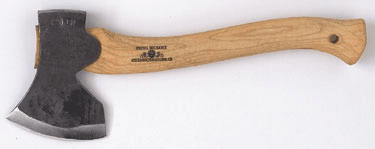
Absence of evidence is not necessarily evidence of absence!
Last edited by Jared Smith on Mon 04 Oct, 2010 2:59 pm; edited 2 times in total
|
|
  |
 |
Jared Smith

|
 Posted: Mon 04 Oct, 2010 2:50 pm Post subject: Posted: Mon 04 Oct, 2010 2:50 pm Post subject: |
 |
|
Also, eyes and shapes I have seen vary significantly. Some could be considered thick tomahawks. One at auction last year in Paris, judged to be 400 to 800 A.D. is actually within 0.25" (6mm) over most of the profile of the tomahawk that I made. (My tomahawk weighed 333 grams, where as this weighed approximately 600 grams due to the true thick maul type body.)
 Attachment: 146.59 KB Attachment: 146.59 KB
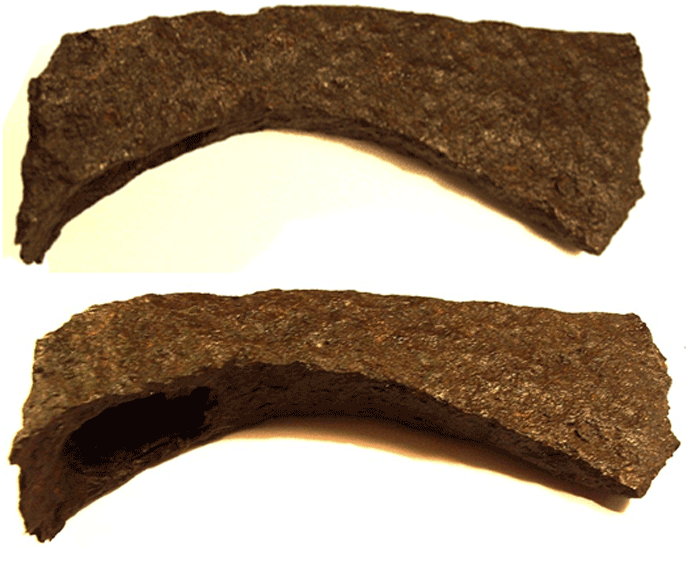
Absence of evidence is not necessarily evidence of absence!
Last edited by Jared Smith on Mon 04 Oct, 2010 2:57 pm; edited 1 time in total
|
|
  |
 |
Jared Smith

|
 Posted: Mon 04 Oct, 2010 2:55 pm Post subject: Posted: Mon 04 Oct, 2010 2:55 pm Post subject: |
 |
|
The style I wish to make is indeed 99% different from what my first trial yielded. Most of the eyes in photos look like imperfect ovals, or slightly tear drop ovals. Admittedly, none look as extreme as tomahawk style drifts produce. Drifting a large eye blindly in something this deep sounds suspicious to me. I would expect an outer layer to be wrapped around an inner core (no big deal compared to present day and original pattern welding feats), or a 50% to 66% size hole to be pre-drilled before drifting. Today, I could drill this "starting hole" for a drift pretty easily. Back then, I would have thought the wrapped around construction to have been easier.
 Attachment: 47.21 KB Attachment: 47.21 KB
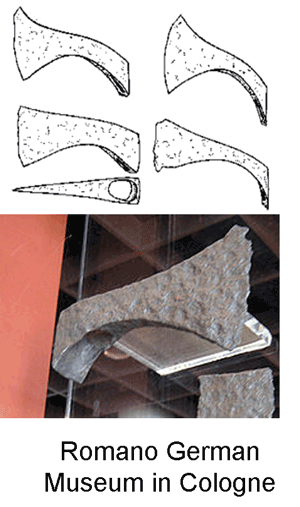
Absence of evidence is not necessarily evidence of absence!
|
|
  |
 |
|
Dustin R. Reagan
|
 Posted: Mon 04 Oct, 2010 3:35 pm Post subject: Posted: Mon 04 Oct, 2010 3:35 pm Post subject: |
 |
|
| Jared Smith wrote: | | Drifting a large eye blindly in something this deep sounds suspicious to me. I would expect an outer layer to be wrapped around an inner core (no big deal compared to present day and original pattern welding feats), or a 50% to 66% size hole to be pre-drilled before drifting. Today, I could drill this "starting hole" for a drift pretty easily. Back then, I would have thought the wrapped around construction to have been easier. |
Either method (drift vs. wrapped & welded) would be well within the ability and technology of a period smith.
You don't have to slit/drift blind. You can cold punch a series of small, very shallow guide depressions, slit using these, drift, then, using a mandrel as a form, correct any issues you might have introduced with drifting such a deep eye.
I have every confidence that a skilled smith can drift eyes even deeper than this with quite a bit of precision; especially so if they have an assistant.
That being said, I think archeological evidence should be the determining factor as to how the eye of these weapons were produced (drifted vs welded).
Cool project, by the way! Thumbs up!
Dustin
|
|
  |
 |
Arne Focke
Industry Professional

|
 Posted: Tue 05 Oct, 2010 12:24 am Post subject: Posted: Tue 05 Oct, 2010 12:24 am Post subject: |
 |
|
| Dustin R. Reagan wrote: | | especially so if they have an assistant. |
Ah, that was what I wanted to add.
With the help of somebody holding the piece steady, you should have no problem punching your way trough.
Just make a shallow guideline, as has been said before, then use a slim chisel to punch a slit all the way through. Don't try making a round hole from the beginning, that usually wanders off in one direction or the other. It is easier first to make a slit and than widen it to form a hole.
I am certainly not the only one who wants too take a look at the outcome, even if it should not be 100% perfect.

So schön und inhaltsreich der Beruf eines Archäologen ist, so hart ist auch seine Arbeit, die keinen Achtstundentag kennt! (Wolfgang Kimmig in: Die Heuneburg an der oberen Donau, Stuttgart 1983)
|
|
   |
 |
Matt Corbin

|
 Posted: Tue 05 Oct, 2010 2:33 pm Post subject: Posted: Tue 05 Oct, 2010 2:33 pm Post subject: |
 |
|
Jared,
Nice first attempt. I'm sure your next effort will be much better.
You might find this thread over on Don Fogg's forum on viking age axe construction helpful:
http://forums.dfoggknives.com/index.php?showtopic=17953&st=0
You may have to register to view the pictures but it's a pretty easy process.
Matt
“This was the age of heroes, some legendary, some historical . . . the misty borderland of history where fact and legend mingle.”
- R. Ewart Oakeshott
|
|
  |
 |
Jared Smith

|
 Posted: Tue 05 Oct, 2010 4:44 pm Post subject: Posted: Tue 05 Oct, 2010 4:44 pm Post subject: |
 |
|
Yes, that does help. I only started my first try with half of that thickness. I will probably end up making an axe eye style drift. More and more of old period originals that I see are really not simple ovals. Below, a 6th century grave find was illustrated by Philippe Delamain in the 19th century. (Original now lost.) http://www.histoirepassion.eu/spip.php?article889 Given the rich quality of other things found with it, and the quality of the illustrations, I see no reason to doubt that it is an elongated axe style eye similar to what is found on Scout or Hunter's hatchets.
 Attachment: 17.89 KB Attachment: 17.89 KB
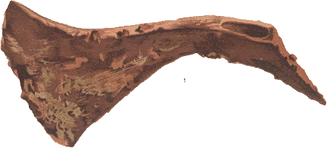
Absence of evidence is not necessarily evidence of absence!
|
|
  |
 |
|
Jeroen Zuiderwijk
Industry Professional
|
 Posted: Wed 06 Oct, 2010 12:34 pm Post subject: Posted: Wed 06 Oct, 2010 12:34 pm Post subject: |
 |
|
| Jared Smith wrote: | | Thanks for the replies Markus and Jeroen. I have not seen any of the reproduction curved handles judged to be "good" by people in your area. I am wondering if it is similar to typical carving axe handles which happen to be of approximately comparable size and weight. An example of what I mean is below. |
Hmm... I actually see that I never should rely on memory on these things, the actual curve in the hilts is the opposite of what I remembered  So a good thing I looked it up. Below is an example from southern Germany, which has a haft reinforcement that shows most of the outline of the original haft (insert: reconstruction). So a good thing I looked it up. Below is an example from southern Germany, which has a haft reinforcement that shows most of the outline of the original haft (insert: reconstruction).
 Attachment: 40.06 KB Attachment: 40.06 KB
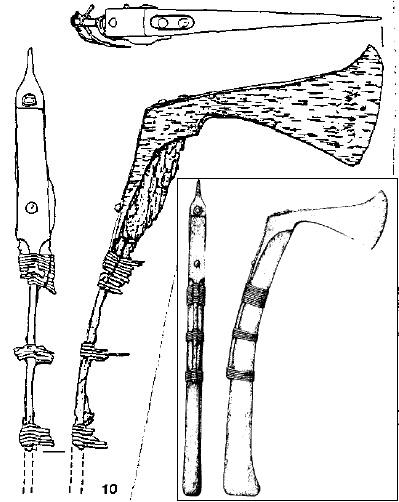
Jeroen Zuiderwijk
- Bronze age living history in the Netherlands
- Barbarian metalworking
- Museum photos
- Zip-file with information about saxes
|
|
   |
 |
|
Jeroen Zuiderwijk
Industry Professional
|
|
   |
 |
Jared Smith

|
 Posted: Wed 06 Oct, 2010 3:50 pm Post subject: Posted: Wed 06 Oct, 2010 3:50 pm Post subject: |
 |
|
| Jeroen Zuiderwijk wrote: |
Hmm... I actually see that I never should rely on memory on these things, the actual curve in the hilts is the opposite of what I remembered  So a good thing I looked it up. Below is an example from southern Germany, which has a haft reinforcement that shows most of the outline of the original haft (insert: reconstruction). So a good thing I looked it up. Below is an example from southern Germany, which has a haft reinforcement that shows most of the outline of the original haft (insert: reconstruction). |
Thankyou very much for the clarification. What you posted could have been inserted from the top, since it looks so small at the grip area. Also, this does not look like any kind of general utility purpose handle such as a hunter's axe would have.
I am very reluctant to make one hafted like a hatchet, from the bottom, and then subject the haft to the kind of abuse that throwing hawks' hafts receive. I may stick with tomahawk handles for now, and try to bend them with a heat lamp and oiling.
Absence of evidence is not necessarily evidence of absence!
|
|
  |
 |
|
Scott Woodruff
|
 Posted: Wed 03 Apr, 2013 7:31 am Post subject: Posted: Wed 03 Apr, 2013 7:31 am Post subject: |
 |
|
Here are a few fransisca photos. Many thanks to all the original posters. There does indeed seem to be a lot of variation in shape, but all seem to have oval eyes that look to me as though they were drifted, though some of the ones with long extensions on the back must have involved some welding. I really like some of the more extreme examples, especially those with beards. Until recently, I thought that fransiscas were pretty uniform in shape and boring, I am so glad to be shown wrong. I do wonder though, what would it be like to drift an eye at such an angle? How would this be accomplished?
 Attachment: 8.64 KB Attachment: 8.64 KB
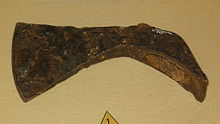
 Attachment: 99.43 KB Attachment: 99.43 KB
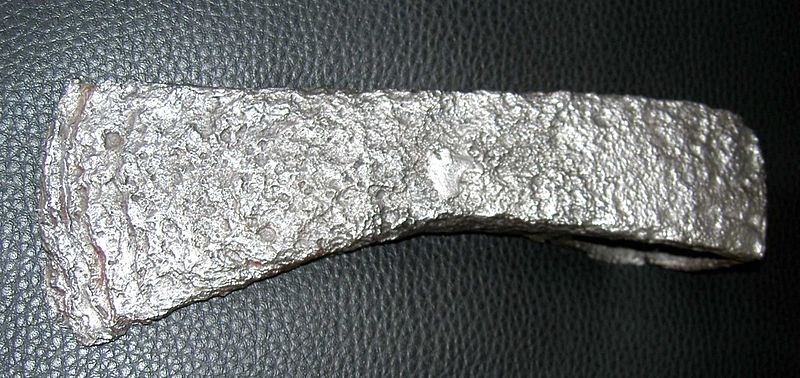
 Attachment: 101.34 KB Attachment: 101.34 KB
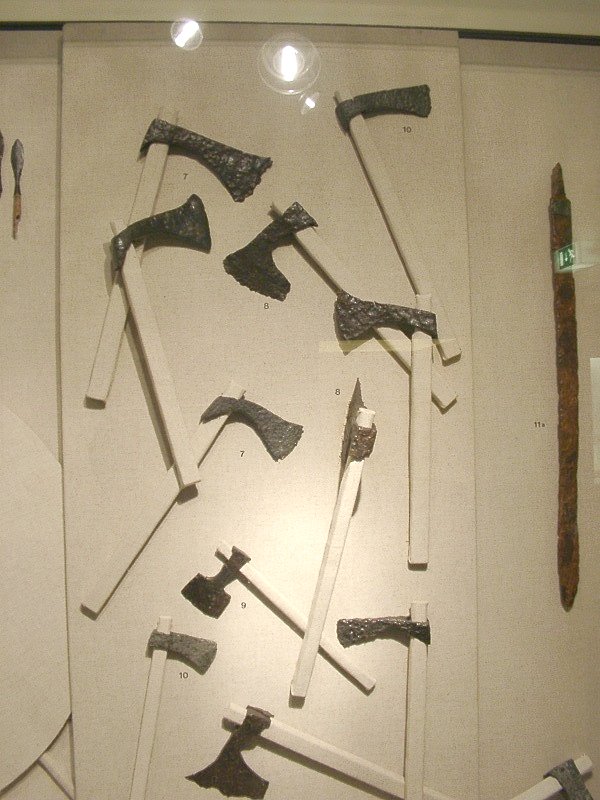
 Attachment: 203.43 KB Attachment: 203.43 KB
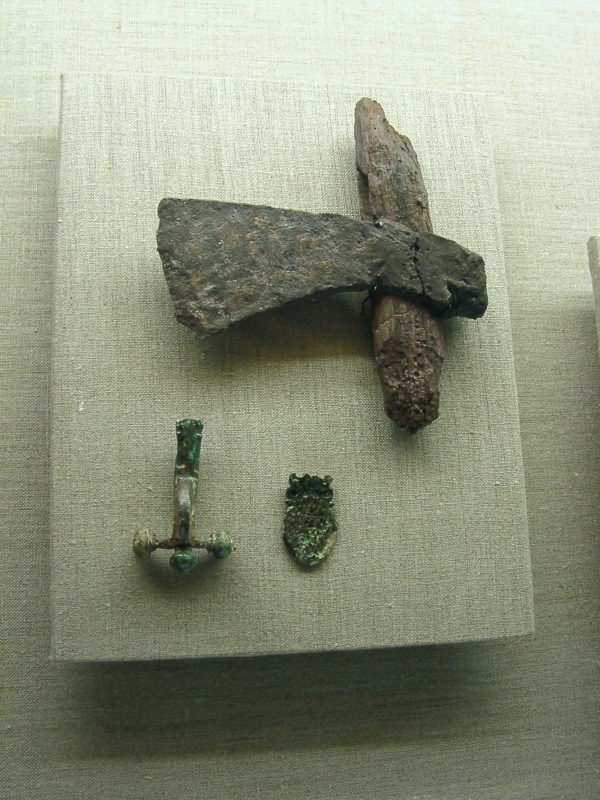
 Attachment: 7.22 KB Attachment: 7.22 KB
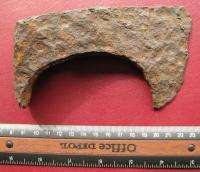
 Attachment: 163.13 KB Attachment: 163.13 KB
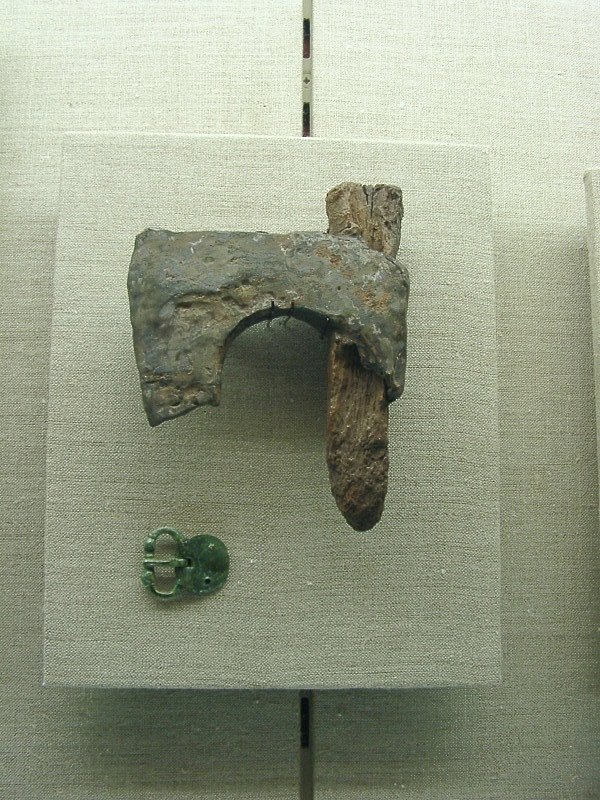
 Attachment: 86.32 KB Attachment: 86.32 KB
[ Download ]
 Attachment: 55.08 KB Attachment: 55.08 KB
[ Download ]
|
|
  |
 |
|
|

